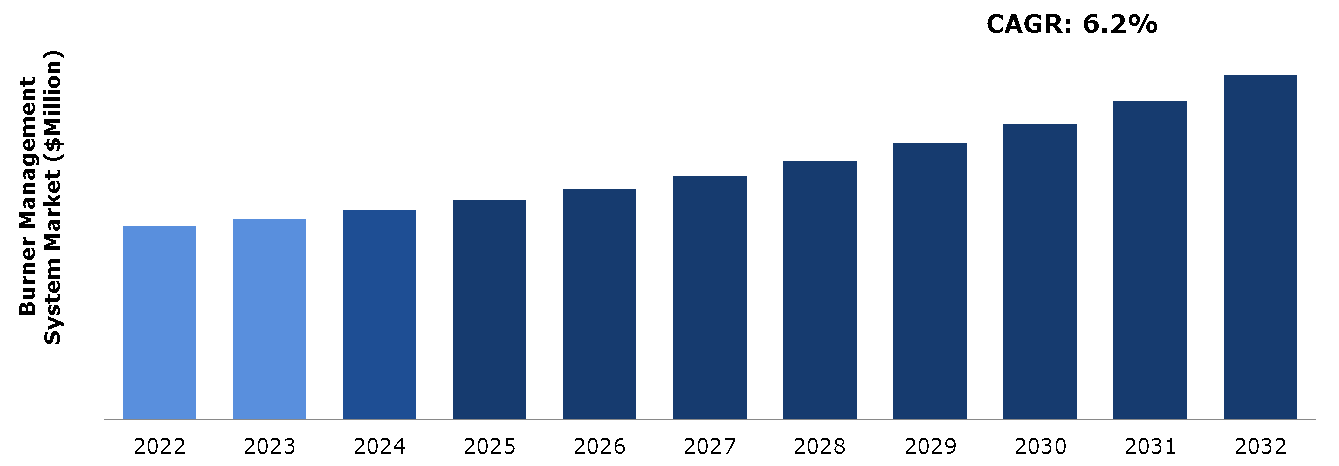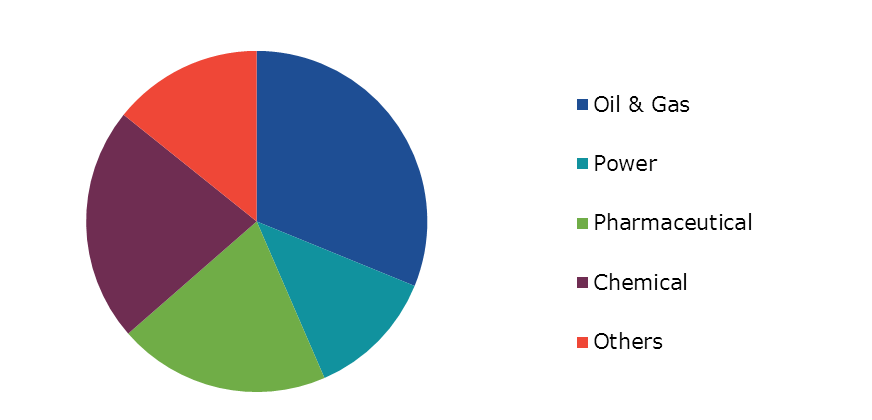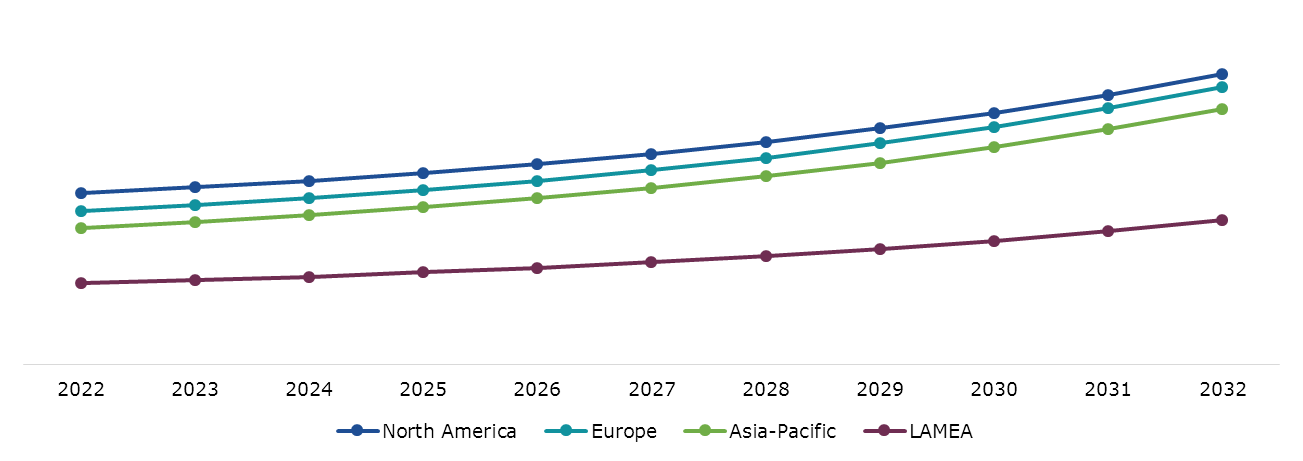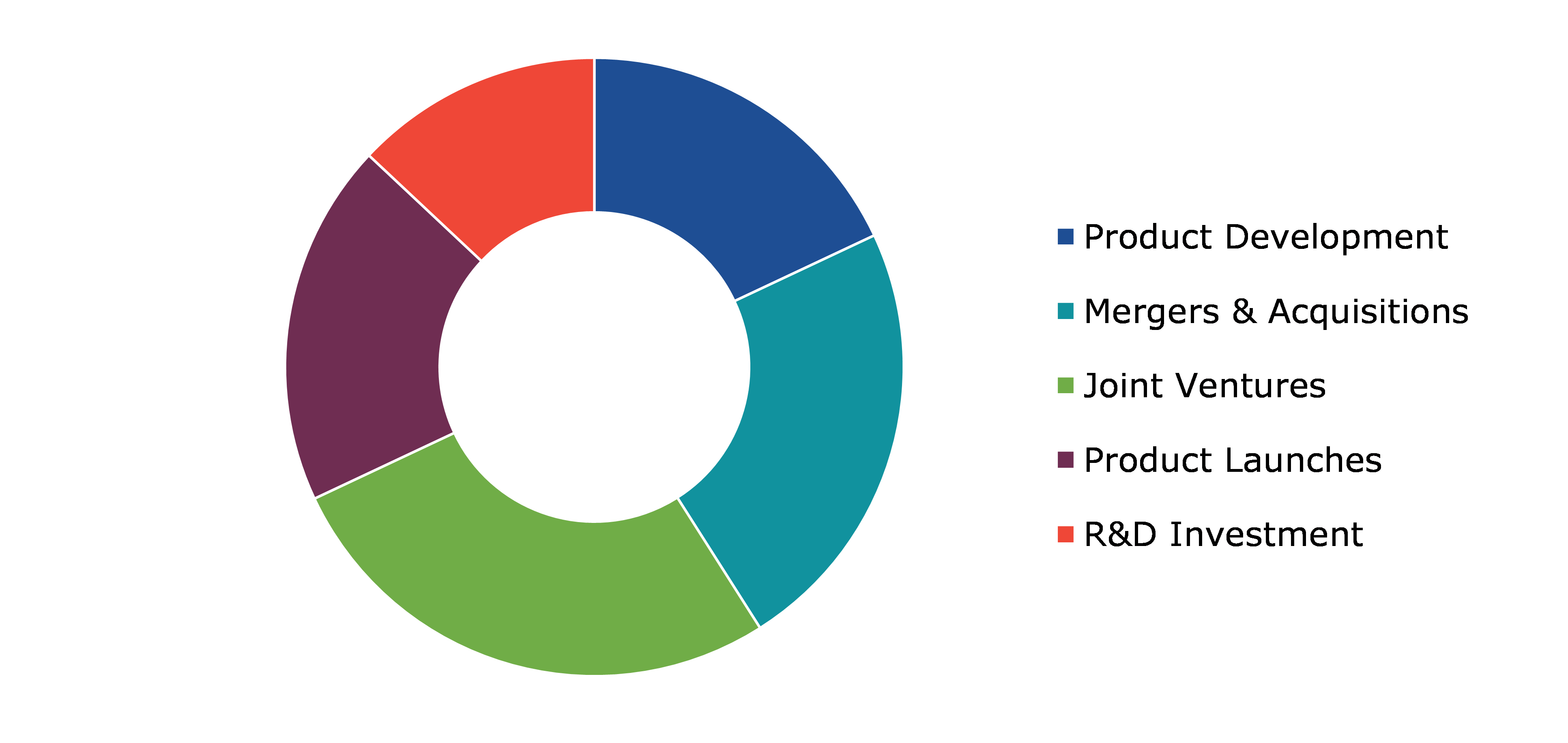Global Burner Management System Market Report
RA00202
Global Burner Management System Market by Platform (Programmable Logic Controller and Distributed Control System), Fuel (Gas, Oil, and Others), End Use (Oil & Gas, Power, Pharmaceutical, Chemical, and Others), Component (Software and Hardware), Application (Multiple Burner and Single Burner), and Region (North America, Europe, Asia-Pacific, and LAMEA): Opportunity Analysis and Industry Forecast, 2023-2032
Burner Management System Overview
Process burners are started, operated, and shut down safely owing to the burner management system. A wide range of industries are progressively adopting burner management systems to enhance plant operations by offering dependable and secure burner operations, which save maintenance costs, guarantee greater safety, and create a safer working environment for plant workers. Flame detectors, ignition systems, fuel valves, safety shut-off valves and control logic are just a few of the parts that make up a typical burner management system. Key parameters like flame presence, burner status, fuel flow, and combustion conditions are continuously monitored by the system. It uses this data to decide how to operate the burner, including starting and halting it, managing fuel flow, and triggering safety shutdowns in the event of unexpected circumstances.
Global Burner Management System Market Analysis
The global burner management system market size was $5,577.00 million in 2022 and is predicted to grow with a CAGR of 6.2%, by generating a revenue of $9,931.20 million by 2032.
Source: Research Dive Analysis
COVID-19 Impact on Global
The COVID-19 pandemic had a major impact on the size of the global burner management system industry. New projects were stopped all around the world, which slowed market expansion. Due to shortage of labors, it has been difficult for global manufacturers to implement modern burner management systems, which has hampered global supply chains. The pandemic’s effects on the burner management system market were temporary since only the supply chain and production were halted. The need for burner management systems is anticipated to rise in the post-pandemic period since they aid in the smooth operation of burners and are and will continue to be the most crucial components for numerous industries.
Rising Demand from Various Industries to Drive the Market Growth
One of the key factors driving the expansion of the burner management systems sector is the surge in demand from various industrial sectors. The market is growing as a result of an increase in the use of burner management systems across a variety of sectors with the goal of improving plant operations by providing dependable and safe burner operations as well as an increase in accident-related lawsuits. Additional market growth factors include the development of governmental laws and regulations, a rise in the demand for the systems due to its reputation for enhancing safety and creating a safer working environment for plant operators. In addition, urbanization, industrialization, and the growth of end-use industries all favorably impact the burner management system market growth.
To know more about global burner management system market drivers, get in touch with our analysts here.
High Cost of Burner Management Systems to Restrain the Market Growth
Implementing a burner management system involves significant upfront costs, including the purchase of equipment, installation, and integration with existing systems. The initial investment required can be a barrier for smaller companies or those operating on tight budgets, limiting their adoption of BMS solutions. Burner management systems have been widely used by the oil & gas, power generating, and chemical industries, while other industries may adopt them more slowly. Advanced burner management solutions may not be prioritized for adoption in industries with less complicated combustion systems or lesser safety issues, which can restrain market growth in those sectors.
Advancements in Technology to Drive Excellent Opportunities
The development of advanced burner management systems, which are capable of monitoring many aspects of boiler control, including the stack temperature, hours of use, amount of fuel used, and boiler efficiency, is a result of the rising popularity of burner management systems. The increase in use of burner management systems across a variety of industries with the aim of improving plant operations and providing dependable and safe burner operations, as well as the increase in accident-related lawsuits, are boosting market expansion. With advancements in communication technologies, BMS can now be remotely monitored and controlled. Industrial operators can access BMS data and make adjustments to burner operations from a central control room or even through mobile applications. This remote accessibility enhances convenience, flexibility, and efficiency in managing burner systems. Technological advancements have led to the development of more sophisticated sensors and monitoring devices. BMS can benefit from these advancements by incorporating advanced flame sensors, gas detectors, and temperature sensors. These sensors provide accurate and reliable data, allowing for more precise control and monitoring of burner operations.
To know more about global burner management system market opportunities, get in touch with our analysts here.
Global Burner Management System Market Share, by Platform, 2022
Source: Research Dive Analysis
The programmable logic controller sub-segment accounted for the highest market share in 2022. Programmable logic controllers offer high flexibility and customization capabilities, making them a preferred choice in BMS applications. They can be programmed to perform various functions and adapt to specific requirements of burner control and safety systems. The ability to easily modify and update the programmable logic controller programming allows for greater control and optimization of the BMS. Moreover, programmable logic controller have a long-standing reputation for reliability and safety in industrial automation applications. They are designed to operate in harsh industrial environments and offer features like redundancy, fault tolerance, and self-diagnostics, ensuring the safe operation of burner systems. Furthermore, programmable logic controller can seamlessly integrate with other automation systems, such as distributed control systems (DCS), supervisory control and data acquisition (SCADA) systems, and safety instrumented systems (SIS). This integration enables effective coordination between the BMS and other plant-wide control systems, enhancing overall operational efficiency and safety.
Global Burner Management System Market Size, by Fuel, 2022
Source: Research Dive Analysis
The gas sub-segment accounted for the highest market share in 2022. Natural gas is one of the most commonly used fuels for industrial and commercial burners due to its availability, cost-effectiveness, and relatively lower emissions compared to other fossil fuels. The rising demand for natural gas as an energy source across various industries, including oil & gas, chemicals, power generation, and manufacturing, drives the need for efficient and reliable burner management systems. Moreover, governments and regulatory bodies around the world have implemented stringent safety regulations and standards to ensure the safe operation of industrial burners. Burner management systems play a critical role in meeting these requirements by providing advanced safety features such as flame detection, fuel control, and emergency shutdown systems. Furthermore, with increasing concerns about climate change and environmental sustainability, industries are actively seeking ways to improve energy efficiency and reduce emissions. Gas burners, when equipped with efficient burner management systems, can provide better control over combustion processes, resulting in improved energy efficiency and reduced emissions. These factors drive the adoption of gas-based BMS solutions.
Global Burner Management System Market Growth, by End Use, 2022
Source: Research Dive Analysis
The oil & gas sub-segment accounted for the highest market share in 2022. Oil & gas facilities rely on burners for various processes, such as heating, drying, and steam generation. An efficient BMS optimizes burner performance, ensuring optimal combustion, energy efficiency, and reduced emissions. By closely monitoring and controlling burner operations, BMS solutions help in maximizing operational efficiency, minimizing fuel consumption, and lowering operating costs. Regulatory bodies and industry standards emphasize the implementation of safety measures, including reliable burner management systems. BMS solutions help in ensuring compliance with safety regulations and standards, reducing the risk of accidents, fires, and explosions. Many oil & gas facilities globally have aging infrastructure that requires modernization and upgrade. This presents an opportunity for the implementation of advanced BMS solutions. By integrating with existing burner systems, BMS technologies can enhance safety, reliability, and performance without requiring a complete overhaul of the infrastructure. In addition, the global demand for energy, particularly in developing countries, continues to rise. Oil & gas remain significant sources of energy, and the exploration, production, refining, and distribution processes involve burners. As the oil & gas industry expands to meet the rising energy demands, the need for efficient and reliable burner management systems also increases.
Global Burner Management System Market Outlook, by Component, 2022
Source: Research Dive Analysis
The hardware sub-segment accounted for the highest market share in 2022. Stringent safety regulations and compliance standards imposed by government bodies and industry organizations play a crucial role in driving the demand for BMS hardware. Industries such as oil & gas, power generation, chemicals, and refineries are required to implement robust safety systems like BMS to ensure the safe operation of burners and prevent accidents. Automation allows for enhanced control and monitoring of burner systems, leading to improved operational efficiency, reduced downtime, and enhanced safety. BMS hardware components, such as flame detectors, control panels, and sensors, are integral to the automation of burner systems. Moreover, energy efficiency is a significant concern for industries due to increasing energy costs and environmental regulations. BMS hardware helps optimize burner operations by monitoring fuel consumption, combustion efficiency, and emission levels. By using advanced hardware components, such as smart sensors and controllers, industrial facilities can achieve better energy efficiency, leading to cost savings and reduced environmental impact. The expansion of industrial infrastructure, particularly in emerging economies, is driving the demand for BMS hardware. As new industrial plants, manufacturing facilities, and power generation units are established, there is a need for reliable and robust BMS hardware to ensure safe and efficient burner operations.
Global Burner Management System Market Analysis, by Application, 2022
Source: Research Dive Analysis
The single burner sub-segment accounted for the highest market share in 2022. Single burner systems are often more cost-effective compared to multi-burner systems, making them an attractive choice for smaller applications or installations where only one burner is required. The initial investment and maintenance costs associated with single burner systems are typically lower. Moreover, single burner systems offer flexibility and scalability, allowing users to easily add or remove burners as per their requirements. Furthermore, managing and controlling a single burner is less complex than handling multiple burners simultaneously. Single burner systems are relatively easier to operate and maintain, requiring less training and expertise. This simplicity appeals to users who prefer a straightforward and less intricate system. Certain applications or industries may have unique requirements where a single burner system is better suited. For example, in small-scale industrial processes, heating appliances, or pilot burners, a single burner system may be sufficient to meet the desired objectives. Single burner systems can be easily retrofitted or upgraded in existing installations. This allows users to replace older or inefficient burner systems with modern BMS technology without extensive modifications or disruptions to the overall system.
Global Burner Management System Market Size & Forecast, by Region, 2022-2032 ($Million)
Source: Research Dive Analysis
The North America burner management system market generated the highest revenue in 2022. North America has strict safety regulations and standards in place for industries such as oil & gas, power generation, and chemicals. These regulations require the implementation of robust safety measures, including the use of advanced burner management systems. Compliance with these regulations drives the demand for BMS solutions in the region. With a rising emphasis on industrial safety, organizations in North America are increasingly investing in technologies that enhance safety measures and reduce the risk of accidents. BMS systems play a critical role in ensuring the safe operation of burners and combustion systems, making them an essential component of safety strategies in various industries. BMS solutions integrate with automation systems to monitor and control burner operations, optimize combustion efficiency, and enhance safety. The increasing implementation of automation technologies in industries such as oil & gas, refining, power generation, and chemicals is driving the demand for BMS systems. Industries are replacing or upgrading their outdated BMS systems to leverage advanced features, improved efficiency, and enhanced safety measures offered by modern BMS solutions. This replacement and upgrade trend is expected to contribute to the market growth in the region.
Competitive Scenario in the Global Burner Management System Market
Investment and agreement are common strategies followed by major market players. In January 2020 – Cimarron Energy, INC. released the most innovative burner management system. Burner management system- ARControl Dual – is designed to assist the oil & gas producers. It operates equipment with dual burners from a single control box.
Source: Research Dive Analysis
Some of the leading burner management system market players are ABB, Cimarron Energy. INC. Emerson Electric Co., Honeywell International Ino., Schneider Electric SE., Tundra Process Solutions, Pilz GmbH & Co. KG, ACL Manufacturing Inc., Combustex Corp., and Rockwell Automation. Inc.
| Aspect | Particulars |
| Historical Market Estimations | 2020-2021 |
| Base Year for Market Estimation | 2022 |
| Forecast Timeline for Market Projection | 2023-2032 |
| Geographical Scope | North America, Europe, Asia-Pacific, and LAMEA |
| Segmentation by Platform |
|
| Segmentation by Fuel |
|
|
Segmentation by End Use
|
|
| Segmentation by Component |
|
| Segmentation by Application |
|
| Key Companies Profiled |
|
Q1. What is the size of the global burner management system market?
A. The size of the global burner management system market was over $5,577.00 million in 2022 and is projected to reach $9,931.20 million by 2032.
Q2. Which are the major companies in the burner management system market?
A. ABB, Cimarron Energy. INC. and Emerson Electric Co. are some of the key players in the global burner management system market.
Q3. Which region, among others, possesses greater investment opportunities in the future?
A. Asia-Pacific possesses great investment opportunities for investors in the future.
Q4. What will be the growth rate of the Asia-Pacific burner management system market?
A. Asia-Pacific burner management system market is anticipated to grow at 6.7% CAGR during the forecast period.
Q5. What are the strategies opted by the leading players in this market?
A. Agreement and investment are the two key strategies opted by the operating companies in this market.
Q6. Which companies are investing more on R&D practices?
A. Honeywell International Ino., Schneider Electric SE., and Tundra Process Solutions are the companies investing more on R&D activities for developing new products and technologies.
1.Research Methodology
1.1.Desk Research
1.2.Real time insights and validation
1.3.Forecast model
1.4.Assumptions and forecast parameters
1.5.Market size estimation
1.5.1.Top-down approach
1.5.2.Bottom-up approach
2.Report Scope
2.1.Market definition
2.2.Key objectives of the study
2.3.Report overview
2.4.Market segmentation
2.5.Overview of the impact of COVID-19 on Global burner management system market
3.Executive Summary
4.Market Overview
4.1.Introduction
4.2.Growth impact forces
4.2.1.Drivers
4.2.2.Restraints
4.2.3.Opportunities
4.3.Market value chain analysis
4.3.1.List of raw material suppliers
4.3.2.List of manufacturers
4.3.3.List of distributors
4.4.Innovation & sustainability matrices
4.4.1.Technology matrix
4.4.2.Regulatory matrix
4.5.Porter’s five forces analysis
4.5.1.Bargaining power of suppliers
4.5.2.Bargaining power of consumers
4.5.3.Threat of substitutes
4.5.4.Threat of new entrants
4.5.5.Competitive rivalry intensity
4.6.PESTLE analysis
4.6.1.Political
4.6.2.Economical
4.6.3.Social
4.6.4.Technological
4.6.5.Environmental
4.7.Impact of COVID-19 on burner management system market
4.7.1.Pre-covid market scenario
4.7.2.Post-covid market scenario
5.Burner management system Market Analysis, by Platform
5.1.Overview
5.2.Programmable Logic Controller
5.2.1.Definition, key trends, growth factors, and opportunities
5.2.2.Market size analysis, by region, 2022-2032
5.2.3.Market share analysis, by country, 2022-2032
5.3.Distributed Control System
5.3.1.Definition, key trends, growth factors, and opportunities
5.3.2.Market size analysis, by region, 2022-2032
5.3.3.Market share analysis, by country, 2022-2032
5.4.Research Dive Exclusive Insights
5.4.1.Market attractiveness
5.4.2.Competition heatmap
6.Burner management system Market Analysis, by Fuel
6.1.Gas
6.1.1.Definition, key trends, growth factors, and opportunities
6.1.2.Market size analysis, by region, 2022-2032
6.1.3.Market share analysis, by country, 2022-2032
6.2.Oil
6.2.1.Definition, key trends, growth factors, and opportunities
6.2.2.Market size analysis, by region, 2022-2032
6.2.3.Market share analysis, by country, 2022-2032
6.3.Others
6.3.1.Definition, key trends, growth factors, and opportunities
6.3.2.Market size analysis, by region, 2022-2032
6.3.3.Market share analysis, by country, 2022-2032
6.4.Research Dive Exclusive Insights
6.4.1.Market attractiveness
6.4.2.Competition heatmap
7.Burner management system Market Analysis, by End Use
7.1.Oil & Gas
7.1.1.Definition, key trends, growth factors, and opportunities
7.1.2.Market size analysis, by region, 2022-2032
7.1.3.Market share analysis, by country, 2022-2032
7.2.Power
7.2.1.Definition, key trends, growth factors, and opportunities
7.2.2.Market size analysis, by region, 2022-2032
7.2.3.Market share analysis, by country, 2022-2032
7.3.Pharmaceutical
7.3.1.Definition, key trends, growth factors, and opportunities
7.3.2.Market size analysis, by region, 2022-2032
7.3.3.Market share analysis, by country, 2022-2032
7.4.Chemical
7.4.1.Definition, key trends, growth factors, and opportunities
7.4.2.Market size analysis, by region, 2022-2032
7.4.3.Market share analysis, by country, 2022-2032
7.5.Others
7.5.1.Definition, key trends, growth factors, and opportunities
7.5.2.Market size analysis, by region, 2022-2032
7.5.3.Market share analysis, by country, 2022-2032
7.6.Research Dive Exclusive Insights
7.6.1.Market attractiveness
7.6.2.Competition heatmap
8.Burner management system Market Analysis, by Component
8.1.Software
8.1.1.Definition, key trends, growth factors, and opportunities
8.1.2.Market size analysis, by region, 2022-2032
8.1.3.Market share analysis, by country, 2022-2032
8.2.Hardware
8.2.1.Definition, key trends, growth factors, and opportunities
8.2.2.Market size analysis, by region, 2022-2032
8.2.3.Market share analysis, by country, 2022-2032
8.3.Research Dive Exclusive Insights
8.3.1.Market attractiveness
8.3.2.Competition heatmap
9.Burner management system Market Analysis, by Application
9.1.Multiple Burner
9.1.1.Definition, key trends, growth factors, and opportunities
9.1.2.Market size analysis, by region, 2022-2032
9.1.3.Market share analysis, by country, 2022-2032
9.2.Single Burner
9.2.1.Definition, key trends, growth factors, and opportunities
9.2.2.Market size analysis, by region, 2022-2032
9.2.3.Market share analysis, by country, 2022-2032
9.3.Research Dive Exclusive Insights
9.3.1.Market attractiveness
9.3.2.Competition heatmap
10.Burner management system Market, by Region
10.1.North America
10.1.1.U.S.
10.1.1.1.Market size analysis, by Platform, 2022-2032
10.1.1.2.Market size analysis, by Fuel, 2022-2032
10.1.1.3.Market size analysis, by End Use, 2022-2032
10.1.1.4.Market size analysis, by Component, 2022-2032
10.1.1.5.Market size analysis, by Application, 2022-2032
10.1.2.Canada
10.1.2.1.Market size analysis, by Platform, 2022-2032
10.1.2.2.Market size analysis, by Fuel, 2022-2032
10.1.2.3.Market size analysis, by End Use, 2022-2032
10.1.2.4.Market size analysis, by Component, 2022-2032
10.1.2.5.Market size analysis, by Application, 2022-2032
10.1.3.Mexico
10.1.3.1.Market size analysis, by Platform, 2022-2032
10.1.3.2.Market size analysis, by Fuel, 2022-2032
10.1.3.3.Market size analysis, by End Use, 2022-2032
10.1.3.4.Market size analysis, by Component, 2022-2032
10.1.3.5.Market size analysis, by Application, 2022-2032
10.1.4.Research Dive Exclusive Insights
10.1.4.1.Market attractiveness
10.1.4.2.Competition heatmap
10.2.Europe
10.2.1.Germany
10.2.1.1.Market size analysis, by Platform, 2022-2032
10.2.1.2.Market size analysis, by Fuel, 2022-2032
10.2.1.3.Market size analysis, by End Use, 2022-2032
10.2.1.4.Market size analysis, by Component, 2022-2032
10.2.1.5.Market size analysis, by Application, 2022-2032
10.2.2.UK
10.2.2.1.Market size analysis, by Platform, 2022-2032
10.2.2.2.Market size analysis, by Fuel, 2022-2032
10.2.2.3.Market size analysis, by End Use, 2022-2032
10.2.2.4.Market size analysis, by Component, 2022-2032
10.2.2.5.Market size analysis, by Application, 2022-2032
10.2.3.France
10.2.3.1.Market size analysis, by Platform, 2022-2032
10.2.3.2.Market size analysis, by Fuel, 2022-2032
10.2.3.3.Market size analysis, by End Use, 2022-2032
10.2.3.4.Market size analysis, by Component, 2022-2032
10.2.3.5.Market size analysis, by Application, 2022-2032
10.2.4.Spain
10.2.4.1.Market size analysis, by Platform, 2022-2032
10.2.4.2.Market size analysis, by Fuel, 2022-2032
10.2.4.3.Market size analysis, by End Use, 2022-2032
10.2.4.4.Market size analysis, by Component, 2022-2032
10.2.4.5.Market size analysis, by Application, 2022-2032
10.2.5.Italy
10.2.5.1.Market size analysis, by Platform, 2022-2032
10.2.5.2.Market size analysis, by Fuel, 2022-2032
10.2.5.3.Market size analysis, by End Use, 2022-2032
10.2.5.4.Market size analysis, by Component, 2022-2032
10.2.5.5.Market size analysis, by Application, 2022-2032
10.2.6.Rest of Europe
10.2.6.1.Market size analysis, by Platform, 2022-2032
10.2.6.2.Market size analysis, by Fuel, 2022-2032
10.2.6.3.Market size analysis, by End Use, 2022-2032
10.2.6.4.Market size analysis, by Component, 2022-2032
10.2.6.5.Market size analysis, by Application, 2022-2032
10.2.7.Research Dive Exclusive Insights
10.2.7.1.Market attractiveness
10.2.7.2.Competition heatmap
10.3.Asia-Pacific
10.3.1.China
10.3.1.1.Market size analysis, by Platform, 2022-2032
10.3.1.2.Market size analysis, by Fuel, 2022-2032
10.3.1.3.Market size analysis, by End Use, 2022-2032
10.3.1.4.Market size analysis, by Component, 2022-2032
10.3.1.5.Market size analysis, by Application, 2022-2032
10.3.2.Japan
10.3.2.1.Market size analysis, by Platform, 2022-2032
10.3.2.2.Market size analysis, by Fuel, 2022-2032
10.3.2.3.Market size analysis, by End Use, 2022-2032
10.3.2.4.Market size analysis, by Component, 2022-2032
10.3.2.5.Market size analysis, by Application, 2022-2032
10.3.3.India
10.3.3.1.Market size analysis, by Platform, 2022-2032
10.3.3.2.Market size analysis, by Fuel, 2022-2032
10.3.3.3.Market size analysis, by End Use, 2022-2032
10.3.3.4.Market size analysis, by Component, 2022-2032
10.3.3.5.Market size analysis, by Application, 2022-2032
10.3.4.Australia
10.3.4.1.Market size analysis, by Platform, 2022-2032
10.3.4.2.Market size analysis, by Fuel, 2022-2032
10.3.4.3.Market size analysis, by End Use, 2022-2032
10.3.4.4.Market size analysis, by Component, 2022-2032
10.3.4.5.Market size analysis, by Application, 2022-2032
10.3.5.South Korea
10.3.5.1.Market size analysis, by Platform, 2022-2032
10.3.5.2.Market size analysis, by Fuel, 2022-2032
10.3.5.3.Market size analysis, by End Use, 2022-2032
10.3.5.4.Market size analysis, by Component, 2022-2032
10.3.5.5.Market size analysis, by Application, 2022-2032
10.3.6.Rest of Asia-Pacific
10.3.6.1.Market size analysis, by Platform, 2022-2032
10.3.6.2.Market size analysis, by Fuel, 2022-2032
10.3.6.3.Market size analysis, by End Use, 2022-2032
10.3.6.4.Market size analysis, by Component, 2022-2032
10.3.6.5.Market size analysis, by Application, 2022-2032
10.3.7.Research Dive Exclusive Insights
10.3.7.1.Market attractiveness
10.3.7.2.Competition heatmap
10.4.LAMEA
10.4.1.Brazil
10.4.1.1.Market size analysis, by Platform, 2022-2032
10.4.1.2.Market size analysis, by Fuel, 2022-2032
10.4.1.3.Market size analysis, by End Use, 2022-2032
10.4.1.4.Market size analysis, by Component, 2022-2032
10.4.1.5.Market size analysis, by Application, 2022-2032
10.4.2.Saudi Arabia
10.4.2.1.Market size analysis, by Platform, 2022-2032
10.4.2.2.Market size analysis, by Fuel, 2022-2032
10.4.2.3.Market size analysis, by End Use, 2022-2032
10.4.2.4.Market size analysis, by Component, 2022-2032
10.4.2.5.Market size analysis, by Application, 2022-2032
10.4.3.UAE
10.4.3.1.Market size analysis, by Platform, 2022-2032
10.4.3.2.Market size analysis, by Fuel, 2022-2032
10.4.3.3.Market size analysis, by End Use, 2022-2032
10.4.3.4.Market size analysis, by Component, 2022-2032
10.4.3.5.Market size analysis, by Application, 2022-2032
10.4.4.South Africa
10.4.4.1.Market size analysis, by Platform, 2022-2032
10.4.4.2.Market size analysis, by Fuel, 2022-2032
10.4.4.3.Market size analysis, by End Use, 2022-2032
10.4.4.4.Market size analysis, by Component, 2022-2032
10.4.4.5.Market size analysis, by Application, 2022-2032
10.4.5.Rest of LAMEA
10.4.5.1.Market size analysis, by Platform, 2022-2032
10.4.5.2.Market size analysis, by Fuel, 2022-2032
10.4.5.3.Market size analysis, by End Use, 2022-2032
10.4.5.4.Market size analysis, by Component, 2022-2032
10.4.5.5.Market size analysis, by Application, 2022-2032
10.4.6.Research Dive Exclusive Insights
10.4.6.1.Market attractiveness
10.4.6.2.Competition heatmap
11.Competitive Landscape
11.1.Top winning strategies, 2022
11.1.1.By strategy
11.1.2.By year
11.2.Strategic overview
11.3.Market share analysis, 2022
12.Company Profiles
12.1.ABB
12.1.1.Overview
12.1.2.Business segments
12.1.3.Product portfolio
12.1.4.Financial performance
12.1.5.Recent developments
12.1.6.SWOT analysis
12.2.Cimarron Energy. INC.
12.2.1.Overview
12.2.2.Business segments
12.2.3.Product portfolio
12.2.4.Financial performance
12.2.5.Recent developments
12.2.6.SWOT analysis
12.3.Emerson Electric Co.
12.3.1.Overview
12.3.2.Business segments
12.3.3.Product portfolio
12.3.4.Financial performance
12.3.5.Recent developments
12.3.6.SWOT analysis
12.4.Honeywell International Ino.
12.4.1.Overview
12.4.2.Business segments
12.4.3.Product portfolio
12.4.4.Financial performance
12.4.5.Recent developments
12.4.6.SWOT analysis
12.5.Schneider Electric SE.
12.5.1.Overview
12.5.2.Business segments
12.5.3.Product portfolio
12.5.4.Financial performance
12.5.5.Recent developments
12.5.6.SWOT analysis
12.6.Tundra Process Solutions
12.6.1.Overview
12.6.2.Business segments
12.6.3.Product portfolio
12.6.4.Financial performance
12.6.5.Recent developments
12.6.6.SWOT analysis
12.7.Pilz GmbH & Co. KG
12.7.1.Overview
12.7.2.Business segments
12.7.3.Product portfolio
12.7.4.Financial performance
12.7.5.Recent developments
12.7.6.SWOT analysis
12.8.ACL Manufacturing Inc.
12.8.1.Overview
12.8.2.Business segments
12.8.3.Product portfolio
12.8.4.Financial performance
12.8.5.Recent developments
12.8.6.SWOT analysis
12.9.Combustex Corp.
12.9.1.Overview
12.9.2.Business segments
12.9.3.Product portfolio
12.9.4.Financial performance
12.9.5.Recent developments
12.9.6.SWOT analysis
12.10.Rockwell Automation. Inc.
12.10.1.Overview
12.10.2.Business segments
12.10.3.Product portfolio
12.10.4.Financial performance
12.10.5.Recent developments
12.10.6.SWOT analysis
Personalize this research
- Triangulate with your own data
- Request your format and definition
- Get a deeper dive on a specific application, geography, customer or competitor
- + 1-888-961-4454 Toll - Free
- support@researchdive.com









